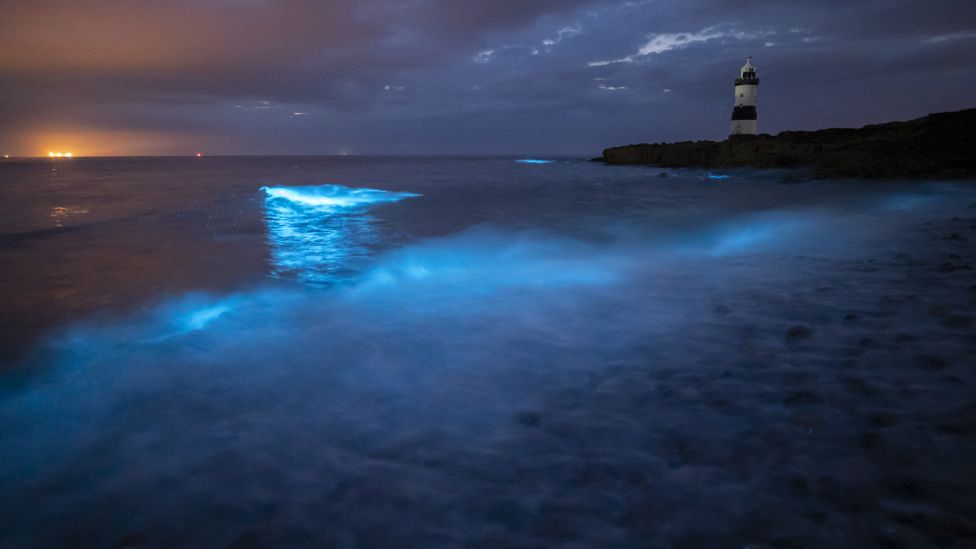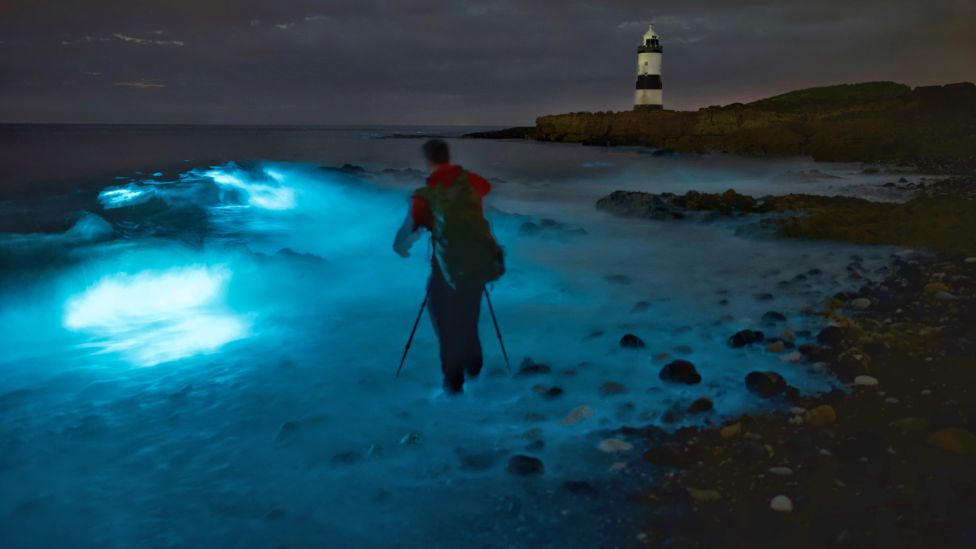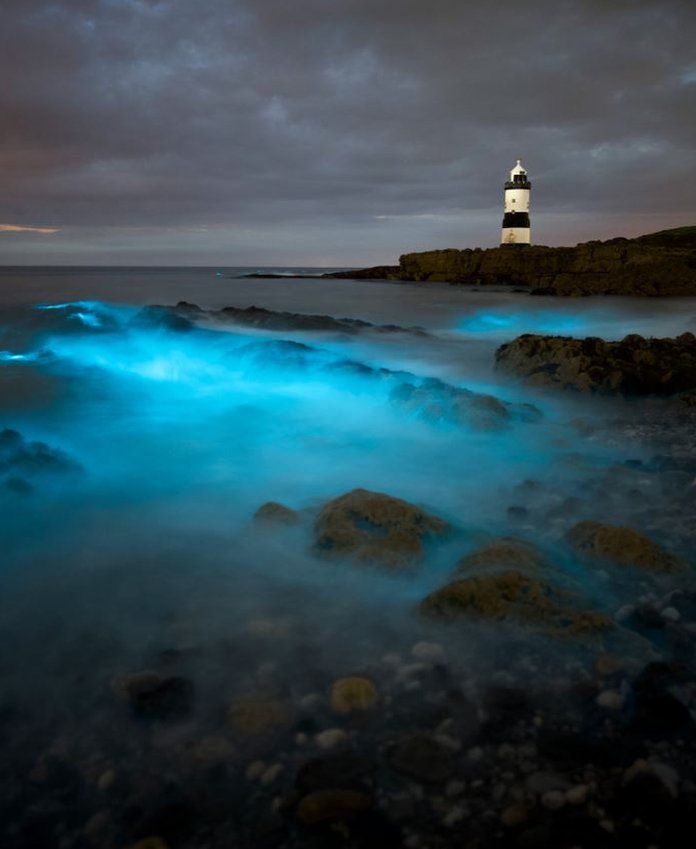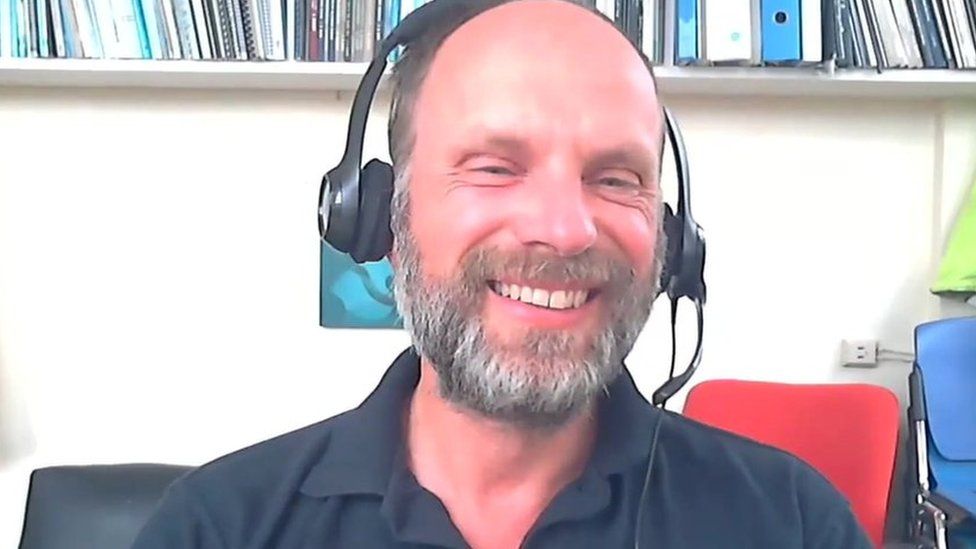Anglesey: 'How we photographed a bioluminescence sea sparkle'
Photographers have been capturing "unforgettable" scenes of the sea lit with glowing plankton bioluminescence.
Bioluminescence describes the light some living creatures, such as plankton and jellyfish, emit from their cells.
But finding and capturing the glow at the right time and right place requires patience, local knowledge and luck, photographers say.
Some have put hours, days and even years into capturing the phenomenon.
Gareth Mon Jones, from Llangefni on Anglesey, said it had been "amazing" to photograph after trying to find it in this concentration for five years.
The 41-year-old was one of several photographers on Penmon Point on Anglesey who became "euphoric" as glowing blue waves began to break on to the shore on 19 June, he said.
"It's like somebody shining a torch from the depth of the water on to the breaking waves.
"It's like a green, turning into electric blue and it comes on to the waves - like champagne bubbles.
"It was just wave after wave of it, and to experience it that concentrated in one area was quite surreal," he said.

Gareth said he visited the beach for 15 nights in a row leading up to the early hours of the Saturday morning.
Finding small amounts of it on seaweed and in rockpools during this time, helped him to "roughly" know it would form in a high concentration.
He said it was "hours" of preparation, with him having power naps after work, before going to search the beaches after dark.
"I'll give it an hour, sometimes two or three depending on what I'm searching for, and where I think it will be.
"It's a case of potluck as well, sometimes, that drives you on."

There's a knack to photographing it too - and "a lot of legwork", Gareth said.
"You don't know if it's there, when it's going to come, what the weather is going to be like - but patience is needed."
"Make sure you're in focus, put your camera into a higher sensitivity and balance the shutter speed to suit you," he added.
"I tend to shoot quite fast to capture it as natural as possible.
"At the end of the day, you're trying to capture something that is flashing in the sea - it's magical."
He added that a shutter speed of two to three seconds on his mirrorless camera helped to capture movement of the water showing the "light trails" formed by the plankton "barrelling" on the waves.

After three years of his own searching, Llion Griffiths, from Abergele in neighbouring Conwy, also managed to clinch shots at Penmon on the same night.
It was his first time seeing bioluminescence so vividly on the sea, the 46-year-old photographer said.
"It was like wave after wave of electricity going through the water.
"It was the most amazing thing I've ever seen."
He said it was an "unforgettable" night and considered himself "privileged and really lucky" to have seen it at that strength.

But Llion said finding and photographing the glow needed dedication.
"You just have to commit to looking around for it, night after night.
"I can't read it, there's no pattern to its appearance. It is not like clockwork.
"Sometimes, you have got to go with your gut feeling - you can only go and do that by spending the hours there," he said.
Although, he added that warm waters and a "west to easterly wind" were good indicators for its appearance in the area.
His advice for taking photos of the bioluminescence was to open the shutter of the camera to draw the light in and get a long exposure.
Mr Griffiths, who uses a DSLR mirrorless camera, said he took "hundreds of shots with the movement of water".
He also said people should be "mindful" of the community and visiting the area, because the sighting of bioluminescence has since attracted a lot of visitors to Penmon.

Marine biology professor at Bangor University's school of ocean sciences, Prof Jan Hiddink, explained this bioluminescence seen around the UK was caused by a type of marine plankton, called dinoflagellates.
These single-celled organisms - less than half-a-millimetre in diameter - can produce a flash of light to scare off potential predators such as shrimp or small fish.
The dinoflagellates appear as orange in the daytime but, when near to the surface at night, their bioluminescence from flashes of light can glow in the dark and be seen.

Prof Hiddink said when the plankton became concentrated in one place and got disturbed - such as by a wave - it could produce a stronger display of bioluminescence.
"It is rare to see it well, because people don't tend to go out in the middle of the night and it tends to happen during summer, when the water is warm and calm," he said.
"You need to line up all these conditions of a dark night during summer, calm warm water, wind direction, and you actually being out there, to see it."
He added the dinoflagellate, called noctiluca, were present in the water "all the time", just not always at the surface where we can see bioluminescence clearly.
By accepting you will be accessing a service provided by a third-party external to https://oc3anclub.com/

